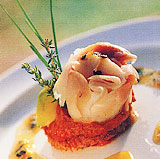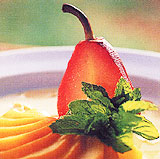|
|
 |
 |
| 03 May 2005 |
Beginners Guide - Pots
In this article in the beginners guide to the kitchen we look at pots in
the kitchen.
GENERAL INFO ON POTS
The material and size of the pot is closely linked to the manner of
heating surface on which it is placed, solid top stoves or individual burners.
The size of the heating surface, determines the bottom area of the pot. Large
pots can be placed on solid top stoves or large individual gas burners, while
smaller size pots are best heated by individual burners or solid top elements.
All pots and pans should be handled carefully, so that they do not fall. This
causes the pot circumference to loose it’s round shape and makes the lid unable
to close tightly. This makes the pot ineffective for it’s purpose, as it looses
too much liquid by evaporation, causing the food to burn easily in the pot.
Never place an empty pot on a hot surface and wait for it to heat up. The heat
will deform and warp the bottom of the pot, making it hollow. This has the
effect,that the surface has no contact with the heating surface and the heat is
not transmitted properly, causing the pot to cook very slowly or not at all.
All pots, kettles and pans, must be stored upside down to avoid dust collecting
inside.
THE MOST COMMON MATERIALS FROM WHICH POTS ARE MADE:
CARBON STEEL
This type of pot is excellent for gas burning stoves due to it’s
excellent heat conductivity.. It is important that the bottom of the pot covers
the heating surface or burner. Small pots go on small burners, big pots are for
large burners or surfaces.
Only the bottoms of the pot or pan, should be heated , otherwise, the handles
get excessively hot and so does the entire kitchen. Flames which are licking
past the bottom of the pot are energy wasters and dangerous. These pots need to
have constant heat control, so that their contents are not burning, as carbon
steel conducts the heat very well and quickly. Wood and steel stirrers and
whisks may be used to stir the pot. Carbon steel pots are cheap to make but
they tend to rust easily. Not suitable for Micro wave but suited for
electricity wood, coal and oil fired stoves.
ALUMINUM POTS
Only fairly thick gauge aluminum pots should be used, as thinner pots deform
and warp easily due to the heat to which they are exposed. Aluminum is an
excellent heat conductor. Wooden and hard, heat resistant, plastic implements,
are the only implements allowed to be used. Steel implements will discolor the
food, due to the fact, that steel is harder than aluminum and scrapes off
minute amounts of aluminum, which oxydise quickly and cause the discoloration
and a bad taste. Aluminum pots are cheap and do not rust, but get pitted by
food acids. Unsuited for Micro wave application but very useful with gas, wood,
coal or oil burning stoves..
STAINLESS STEEL POTS
Stainless steel, is a bad conductor of heat. It tends to transfer heat
directly on the spot, causing the food to burn, but a few centimeters beside
the heated spot, the pot may be quite cool. It is for this reason, that
stainless steel tilting pans tend to reflect the heat and warp or burn out the
elements.
Stainless steel pots need to be provided with a copper bottom to spread the
heat. A Teflon bottom and a Thick bottom with Teflon or a copper inset which is
glued to the stainless steel will help to spread the heat evenly. Excessive
heating of the empty pot will cause the thick, glued bottom to warp and
separate from the stainless steel , making the pot totally unfit for it’s
purpose.
Stainless steel pots are very expensive but do not rust and have a long working
life. Not suited to Micro wave applications but can be used on electricity,
coal, oil and wood burning stoves.
COPPER KETTLES AND POTS
Copper is the best conductor of heat available. Copper pots are best
for working with sugar. However, the pots, kettles and pans need to be heavily
tinned, to avoid poisons which are formed between acidic foods and the copper,
which cause verdigris to form which is green colored and poisonous. The pots
are difficult to keep clean as the need to be burnished daily to keep their
luster. Copper is very soft and easily dented and this can be a problem.
Handles on copper pots, tend to be made from wood and need to be screwed or
riveted to the pot, which can cause leakages. Copper is very expensive and
labor intensive but very beautiful. Wood implements and stainless steel are the
best to work with.
Cannot be used in a micro wave but can be used with electricity, coal, wood and
oil burning stoves.
CAST IRON POTS AND PANS
These pots and pans conduct heat very effectively and are excellent
for braising, pot roasting and griddling or frying. A draw back it the weight
which is very heavy and the fact, that cast iron cracks and rusts easily. Cast
iron is also not cheap any more and is very difficult to clean. For storage,
cast iron needs to be greased, oiled or sprayed with spray and cook. Wood
implements and stainless steel whisks are the best to work with. Unsuitable for
micro wave. Usable for oil, coal, wood and gas furning stoves.
VITREOUS CHINA OR GLAZED OVEN WARE
These containers are very thin walled and cannot take excessive heat,
they are also easily chipped, which makes them unsuitable for professional
kitchens due to rust and metal interacting with food acids. However, these pots
are relatively cheap. Unsuitable for micro wave, but can be used with a heat
deflector on gas. Wood, coal and oil and electric heated ovens are also
allowed.
FIRE PROOF GLASS AND OVEN TO TABLE WARE
These pots and pans are slow conductors of heat. They are very easy to
clean and have the advantage that they can be taken from the oven to the table
or the fridge without ill effects. Their cost is reasonable. However, they are
not sufficiently large enough to be used in a professional, high turn over
establishment, unless it is for small quantity desserts. They are Micro wave
usable can be used with all types of ovens and stoves.
PANS
All the above materials are used for pans and the same rules and
applications apply.
Choose your equipment according to the type of fuel and stove which you use
in your kitchen.
|
|
 |
 |
|
|
|




